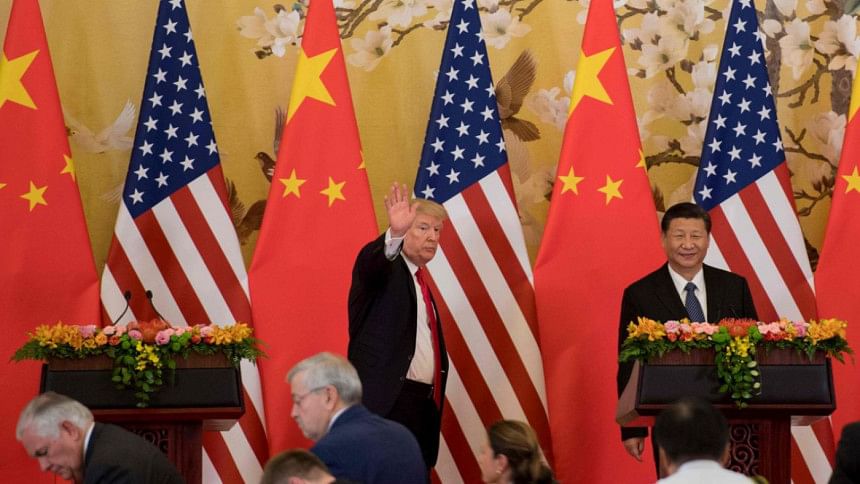What does Bangladesh gain from the US-China trade war?

As the US-China trade war intensifies, pundits on both sides of the Pacific and elsewhere are wondering: who is the real winner? Interestingly, it is not China or the United States, but countries like Bangladesh, Vietnam, and Chile that may reap the most benefits from a widening trade dispute between the world's two biggest economies. The impending effect of the trade war on supply chain dynamics and investment patterns could help Bangladesh emerge as a potential winner from the conflict.
China and the United States have been stable trade partners to Bangladesh for decades. The volume and value of trade Bangladesh has with both countries are significant. However, the nature of trade with both countries is different. Bangladesh's top import partner is China, with Bangladesh importing over USD 15 billion in Chinese goods as of 2017. Meanwhile, the United States is the second largest destination for Bangladesh's exports, taking in more than USD 5.8 billion in 2017 (Germany was the largest destination at just over USD 6 billion).
The changes in the geopolitical relationship between the United States and China through this trade war have alarmed many countries that have trade stakes with these two nations—though this raises hope for Bangladesh. As the Asia Development Bank's chief economist Yasuyuki Sawada argues, "Trade war to generate additional USD 400 million exports for Bangladesh."
Unlike Chinese FDI, Bangladesh can also benefit by increasing imports from the United States. According to the American Farm Bureau Federation, soya bean exports to China have declined by 97 percent after China's tariffs on American soya beans came into effect. If the country can redirect its supply chain from Latin America to the United States, it may have the potential to supply oil to consumers at cheaper prices without sacrificing profits in the long run.
The garment sector is expected to reap the most benefits, as it accounts for 80 percent of Bangladesh's total exports. As the trade war escalated, the country's garment industry observed significant growth as American retailers are placing more work orders with Bangladesh in order to offset increasing tariffs. According to the US Office of Textile and Apparel (OTEXA), Bangladesh enjoyed a 6.46 percent growth in share in the United States' market during the first three quarters of 2018.
In 2012, a report by McKinsey forecasted that as ready-made garments from China declined, Bangladesh would become the next hotspot for textile manufacturing, and the Bangladeshi market would triple in value by 2020—up from USD 15 billion in 2010. This forecast entails China's gradual phasing out from labour-intensive industries to a higher value-added, high-tech, capital-intensive manufacturing sector and a greater Bangladeshi stake in labour-intensive industries such as the textile industry.
To avoid higher tariff, factories are relocating from China to elsewhere in Asia. Bangladesh has more competitive advantages than its competitors such as Cambodia and Vietnam. Due to the presence of strong unions, setting up factories in Cambodia is more challenging these days. Moreover, in contrast to 160 million Bangladeshis, Cambodia has a population of just 16 million, which gives Bangladesh a competitive edge for this labour-intensive industry.
Due to higher wage and production costs, Vietnam also looks less attractive to investors. The minimum wage in Bangladesh is currently USD 95 per month, which is almost half of USD 182 per month in Cambodia and USD 180 per month in Hanoi and Ho Chi Minh City.
Unlike Chinese foreign direct investment (FDI), Bangladesh can also benefit by increasing imports from the United States. According to the American Farm Bureau Federation, soya bean exports to China have declined by 97 percent after China's tariffs on American soya beans came into effect. Currently, Bangladesh imports 2 million tonnes of crude vegetable oil, of which 30 percent or 600,000 tonnes is soya bean; 98 percent of those soybeans come from Argentina, Paraguay, and Brazil. If the country can redirect its supply chain from Latin America to the United States, it may have the potential to supply oil to consumers at cheaper prices without sacrificing profits in the long run.
Moreover, being the 51st largest trading partner of the USA, Bangladesh enjoys USD 4.0 billion trade surpluses. As President Trump is going after one trade-surplus country after another, Bangladesh, by importing soya bean from the USA, can be benefited both by getting it at a cheaper rate and reducing the trade deficit that may ultimately contribute to stronger bilateral relations. Furthermore, Bangladesh and other low-income countries in South Asia face US duties of 15.2 percent of the total value of exports, which has a possibility to ease if the US wants to increase imports from these countries to minimise its gap from China.
The majority of steel demands of Bangladesh come from importing scrap iron from the United States and its domestic ship-breaking industry. However, the US imposed a 25 percent tariff on all steel imports in March 2018, in efforts to revitalise its declined steel industry. This action led the US suppliers of scrap iron to store their reserves in anticipation of higher tariffs. Consequently, Bangladesh has seen a significant rise in the price of rod, an important product required for its many infrastructure projects.
In 2017, Bangladesh scrapped 25 percent of the ships dismantled worldwide and it is considered as a prospective industrial sector. In light of growing development projects, the country might craft an industrial policy to develop its shipbreaking yards, hoping to source a greater amount of cheaper steel domestically, which is already providing more than half of the country's steel supply.
Although Chinese policymakers are seeking to tighten capital flows in hopes to prevent a depreciation of the yuan, China's increasing involvement in various projects of Bangladesh may mean these constraints will not be as effective in the case of Bangladesh. Additionally, Bangladesh sees an increase in foreign direct investment (FDI) from China to be higher than forecasted through factory relocations, especially in the growing export processing zones (EPZs), as the trade war increases the costs of doing business in China.
Furthermore, since Bangladesh is a member of the Belt and Road Initiative (BRI), it is more meaningful for China to increase the investment in sectors of Bangladesh that are affected in China by the trade war. Beijing's support of Bangladesh was evident in the 27 agreements for investments and loans signed by the two countries—amounting to USD 24 billion—when President Xi Jinping visited Dhaka in 2016. The net FDI from China into Bangladesh exploded after Xi's visit. It increased to USD 506 million in the 2017-18 financial year, which was only USD 68.5 million in 2016-17, according to The Financial Express.
Putting all these together, it clearly appears that the unwarranted trade war between the United States and China opens a sudden window of opportunity for Bangladesh. However, whether the country can reap those benefits will depend on a host of factors. Bangladesh is struggling with a crumbling infrastructure, a weak rule of law regime, and a poor business environment. Many observers are also alarmed that Bangladesh government's excessive and reckless borrowing from Chinese credits may put the country in a longer-term debt trap, like some other countries.
It is, therefore, critical for Bangladesh to work on a favourable policy regime to seize new opportunities as they come by, and to provide enabling conditions for more foreign direct investments—all by avoiding unintended risks and consequences.
Anu Anwar is an Affiliate Scholar at East-West Center, and a Fellow at the Pacific Forum, Hawaii, USA.
Follow The Daily Star Opinion on Facebook for the latest opinions, commentaries and analyses by experts and professionals.
To contribute your article or letter to The Daily Star Opinion, see our guidelines for submission.

 For all latest news, follow The Daily Star's Google News channel.
For all latest news, follow The Daily Star's Google News channel. 



Comments